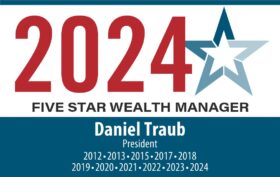January 2012
I’m beginning to think that Rip Van Winkle was onto something. This classic tale takes place during the time of the American Revolution. Rip avoided the hardship of war by sleeping through the revolution. Ah, ignorance is bliss!
Anyone who somehow tuned out in 2011 may have saved him or herself much stress as well. An investor who only looked at year-end statements for 2010 and 2011 might reasonably conclude that not much happened during the year. Au contraire! In fact at times it seemed the whole world might fall apart. The turmoil in the mid-east, the tsunami and nuclear meltdown in Japan, and the economic meltdown in Europe (with worldwide implications) all kept 2011 rather interesting.
The biggest lesson we can learn from old Rip Van Winkle is not that we should ignore what is going on around us. It is that we should not over-react. Between August and September I received quite a few calls from clients (and others) wondering if they should take risk off the table and become more conservative or, worse, sell it all. If I got a few calls you know there were millions of people across the country wondering the same thing. Recall that in September the world was in turmoil and the market seemed to be in a free fall, down nearly 20% in just a few months.
I advised people to stay the course, that the market would not implode, and that if they really want to become more conservative the time to do so is closer to a peak than a trough. Happily everybody listened – and they were rewarded.
The fourth quarter turned out to be a strong period to invest. While many equity benchmarks gained over 10%, bonds were much less profitable, gaining closer to 1%. And though the year as a whole was plus or minus break even imagine how much worse off you would be if you had sold in September.
By the end of the year most returns hovered around the break-even level. Large cap US equities were slightly positive (S&P 500 up 2.1%), bonds were up modestly (BarCap Aggregate Bond Index up 7.7%), small cap US equities were modestly negative (Russell 2000 down -4.2) and foreign stocks were down more significantly (EAFE down -12%).
While the U.S. economic recovery continues to be weak recent data suggest that at a minimum the recovery will continue. Stable retail sales and (modestly) declining unemployment figures might allow us to even be a tad optimistic and conclude that the recovery is picking up steam.
Tempo Financial Advisors’ 4th Quarter Investment Performance
As you would expect in a solidly positive 4th quarter, the Tempo Lifestyle Program did the best job of capturing the gains. Returns ranged from gains of +6% for conservative accounts to close to +10% for more aggressive accounts. These returns makes sense when you consider that more conservative accounts hold more bonds and bond returns were modest by comparison to stocks.
The opposite can be said with respect to returns for 2011 as a whole when conservative accounts performed better than aggressive ones. Conservative accounts were approximately break-even for the year while more aggressive accounts lost close to -2%. Why? While the fourth quarter was better for stocks the year as a whole was better for bonds. More bonds in conservative accounts lead to better returns.
All accounts suffered in 2011 in comparison to the S&P 500 which was the best performing major benchmark for the year. Because we maintain diversified portfolios we have exposure to mid-cap U.S. equities, small-cap U.S. equities, and international equities all of which had negative returns for the year (returns of -1.7%, -4.2%, and -12.3% respectively). And while there will be times such as this where diversification does not appear to pay off, more often than not it does (refer to the 3Q Tempo Vantage for more comments on diversification). For example our over-weight positions in healthcare and real estate performed better than the overall market in 2011.
The Tempo Dynamic Income and Dynamic Growth Programs also experienced very successful 4th quarters with returns of +4.5% and +6.1%, respectively. These returns rank above the 80th percentile of each program historically. We are very happy when our conservative strategies capture this much of a strong market.
2011 as a whole was also successful for the Dynamic Income Program which gained +2.2% for the year. While this return was in line with some bond benchmarks and behind others, any strategy with a positive return for the year given the extreme volatility must be considered a success.
Unfortunately we can’t say the same for the Dynamic Growth Program which lost -2% for the year. At the end of the day while we were pleased with returns in quarters 1, 2, and 4, we could not overcome the negative return in the 3rd quarter, when we lost more than we typically do, even adjusting for the extremely negative market at that time.
Company News
Thanks to all of you who were able to join me for the wine tasting event held in November at the Sel de la Terre Restaurant in Natick. Maybe you all are just being nice but I have heard only good reviews of the event. Hopefully this is the sort of thing we can do again and even more of you can join us.
Reminder
Please contact us if there has been a change in your financial circumstances that would warrant a fresh perspective on your portfolio.
Daniel J. Traub
